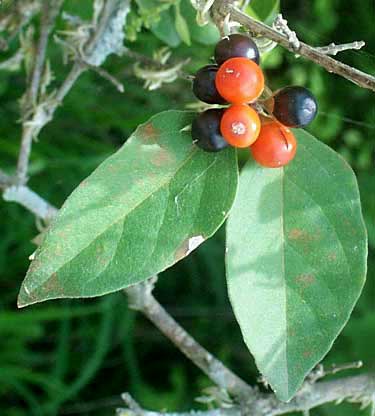Excerpts from Jim Conrad's
Naturalist Newsletter
from the July 13, 2007 Newsletter issued from Jalpan; N21.23°, W99.47°, elevation ~800m (~2600ft); northern Querétaro state, MÉXICO
FIDDLEWOOD FRUITS CHANGING RED TO BLACK
A common bush or small tree around here flowering now is a CITHAREXYLUM species, keying out to C. berlandieri, sometimes known in English as Fiddlewood. The lustrous fruits start out as green ovaries, turn orangish, and then at maturity finally black. You can see the fruits below.

The fruits of several species turn orange or red before maturing to black. For example, blackberries and several viburnum, mulberry and plum species follow the same green --> red --> black pattern. Therefore, is there an advantage to this color-changing strategy? For example, might the red fruits attract birds who come and then eat the black, ripe fruits, whose seeds are more ready for dispersal?
Finding answers hasn't been as easy as might be expected. One complication of the issue is this: Birds don't see the landscape the way humans do; they live in a much, much more colorful world.
Human eyes have three kinds of cones (one of two kinds of photoreceptors in the eye's retina) while birds have four. The extra cone type enables birds to see twice as many colors as humans, as well as ultraviolet light. Therefore, what looks to a human like a red fruit turning black may look much more spectacular and complex to a bird.
For my part, I'm glad that even today the world of science hasn't figured out all the mystery inherent in something as simple as a fruit being red right before it matures, then turning black.
By the way, while Googling this matter I ran into a thought-provoking sentence I haven't been able to confirm or disprove yet. Here it is:
"Even though you may be camouflaged and in a blind, European Starlings can see in the UV spectrum, so they can see you glowing below them."